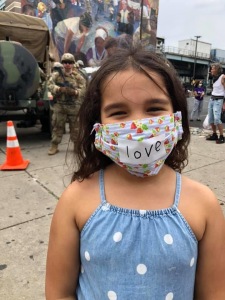
At breakfast every morning, Harriet asked her mother, “Is Gogo coming today?” Most mornings were the same at Harriet’s house. Daddy read the Bible and prayed, and then he got ready to teach his classes, told the man who worked around the house during the day what he was supposed to do, and answered the man’s questions. He said goodbye to Harriet and Mommy and went to work. Sometimes Harriet’s big brother John was there but most of the time he was far away at school. Sometimes Mommy stayed home and did stuff around the house like sewing, knitting, cooking, and playing with Harriet; sometimes she went to work too.
Whenever Mommy and Daddy were both busy, Gogo came and took care of Harriet. They played together. Gogo fixed lunch for Harriet, sang songs to her when she took her nap, and came to get her when she woke up from her nap. She played with Harriet’s hair, and Harriet played with hers. She took Harriet to the house where she lived with other women workers. Harriet listened while Gogo talked to her friends. She couldn’t understand what they were talking about but she liked the funny clicking sounds. Gogo’s name wasn’t really Gogo, but that’s what Harriet liked to call her.
Harriet often felt like she had two mothers, and she loved them both.
Gogo took Harriet for rides around the mission station in Harriet’s little wooden wagon. They went to Gogo’s house, to other missionary houses, and down the big road lined with tall gum trees that went to town. One time, when Gogo pulled the wagon over a small rock in the road, it tipped sideways and Harriet fell out. She bumped her head on the ground and scraped her hands on the rough stones. She cried because she was scared and her head and hands hurt. Gogo quickly picked her up and hugged her; she kissed her head and hands and told her it was okay to get back in the wagon. She took her home. Harriet felt loved and cared for. She never forgot how Gogo took care of her when she fell out of her wagon.
Then one day, Harriet heard Mommy and Daddy talking. Daddy was telling Mommy that they had to move to another house. They had to pack up all their things and take them to a different house far away. Harriet didn’t understand what moving was like because she had always lived at Matopo. It sounded exciting but also kind of scary. Harriet liked the house she lived in and all the things she could do with Mommy, Daddy, John, and Gogo. She wasn’t sure she wanted to move somewhere else.
The day came for the big move. They packed everything in a lorry and drove a long way to Wanezi. Everything was really different at the new house. Harriet’s bedroom was in a different place. There weren’t any big rocks to climb on outside. There wasn’t a big road lined with big trees.
The first morning at the new house, Harriet asked, “Is Gogo coming today?” Daddy said Gogo wouldn’t be coming anymore. She had stayed at her own house at Matopo. Harriet didn’t understand why Gogo didn’t come with them to the new house. Every day she asked again, “Is Gogo coming today?” and every day Daddy said the same thing, “Gogo isn’t here. She stayed at Matopo.”
Harriet was very sad and missed Gogo. She didn’t know how to explain that she was sad, and Mommy and Daddy didn’t seem to understand how sad she was. Soon she stopped talking to Daddy. Every time Daddy asked her a question, Harriet wouldn’t answer. She just looked at Mommy and said nothing, or maybe she would say something to John and then John would tell Daddy what she said.
Mommy and Daddy tried lots of ways to make Harriet talk to Daddy. Mommy would say, “If you want another cookie, you’ll have to ask Daddy.” Harriet decided she didn’t want a cookie if she had to ask Daddy. Or Daddy would ask, “What did you do today?” Harriet wouldn’t say anything and would hide behind Mommy’s skirt. Mommy and Daddy told John to ask Harriet why she wouldn’t talk to Daddy. She told John, “When Daddy takes us back to Matopo, then I’ll talk to him.” She thought that if they went back to Matopo, she could see Gogo, and maybe Gogo would come and play with her again.
After they had lived for a while at Wanezi, Harriet and her family went for a long vacation. Harriet still wasn’t talking to Daddy. While they were on vacation, she saw a book about a kitten in a store. The book was called Katie the Kitten. Harriet really liked books and she loved kittens, so she wanted that book. She told Mommy about the book and she talked about it to John. But she never asked Daddy. Every time they passed the store while they were out for walks, Harriet pestered Mommy to buy the book for her. She wanted that book so much!
Finally, Mommy said she could have it. Harriet was so excited. But then Mommy said, “Daddy will take you to the store, and if you ask him, he’ll buy it for you.” That made Harriet sad all over again. She didn’t want to ask Daddy; she just wanted Mommy to take her to the store to buy the book. But since she really wanted that book, she went along with Daddy. She held his hand while they walked and crossed all the streets on the way to the store. Harriet felt safe with Daddy, and he took good care of her. She still didn’t want to talk him though. She still missed Gogo and wondered why Daddy didn’t understand that.
When they got to the store, Harriet and Daddy went in. Harriet pointed to the book. There it was, on a shelf by the window, right where it had been before when she and Mommy walked by. Daddy waited for Harriet to ask him if she could have the book, but she didn’t say anything. She just stood quietly beside him, holding his hand and looking at the book. They stood there together for a long time. Finally, Daddy asked, “Harriet, would you like to have the book?” Harriet nodded yes, but she still didn’t say anything out loud. Daddy took the book off the shelf and handed it to Harriet. Then he took some money out of his pocket, gave it to Harriet, and told her to take the money and the book to the storekeeper. The storekeeper took the money from Harriet, wrapped the book carefully in tissue paper, put it in a bag, and handed it to Harriet. She gave Harriet a big smile and said, “Enjoy your new book. Ask your Daddy to read it to you when get home!”
Harriet and Daddy walked home together. Harriet held Daddy’s hand again, and in her other hand she proudly carried the bag with her new book. She was so happy; she couldn’t wait for Daddy to read the book to her while she looked at all the pictures of the cute little kitten called Katie.
Harriet still didn’t talk to Daddy for a long time. She stayed sad and missed Gogo, and she wished Daddy would take her back to Matopo to see Gogo or let Gogo come live with them at Wanezi. But as she grew up, Harriet began to forget about Gogo and didn’t miss her so much. And she started talking to Daddy again.





